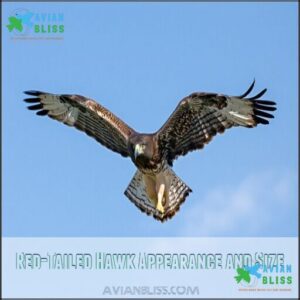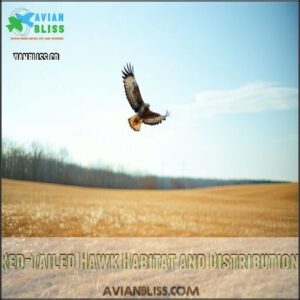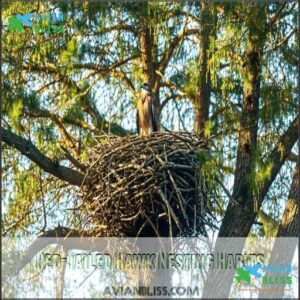This site is supported by our readers. We may earn a commission, at no cost to you, if you purchase through links.

You’ll spot red-tailed hawks perched alongside highways, scanning for their next meal, while ospreys dive dramatically into lakes for fish.
Bald eagles, with their unmistakable white heads, are a symbol of strength and freedom, often seen near large bodies of water.
Falcons, like the speedy peregrine, streak across the sky like feathery arrows.
Each plays a critical role in the ecosystem, keeping rodent populations in check, and they influence our everyday lives in surprising ways.
Table Of Contents
- Key Takeaways
- Falcons, Kites, and Harriers in North Carolina
- Rare Species and Conservation
- Osprey and Bald Eagle in North Carolina
- Red-Tailed Hawk Identification and Habitat
- Red-Tailed Hawk Nesting, Reproduction, and Conservation
- Other Birds of Prey in North Carolina
- Birds of Prey and Human Interactions
- Finding and Caring for Injured Birds of Prey
- Frequently Asked Questions (FAQs)
- How many birds of prey are in North Carolina?
- What birds of prey can you spot in North Carolina?
- Are there any big birds in North Carolina?
- What is the smallest bird of prey in North Carolina?
- What are some common birds of prey?
- Are broad wing hawks common in North Carolina?
- What is the most common hawk in North Carolina?
- Did I see a hawk or a falcon?
- What is the big bird in North Carolina?
- What bird is mistaken for a hawk?
- Conclusion
Key Takeaways
- You’ll find over 20 species of birds of prey in North Carolina, including Bald Eagles, Peregrine Falcons, and Red-tailed Hawks, each thriving in diverse habitats.
- Falcons like the Peregrine Falcon dive at speeds up to 240 mph, while the Northern Harrier’s owl-like face helps it hear prey hiding below.
- Bald Eagles and Ospreys are often spotted near water, hunting fish with precision, showcasing their key role in aquatic ecosystems.
- Conservation efforts, like habitat protection and nesting platforms, have helped protect raptors like the Peregrine Falcon and Osprey, ensuring their populations recover and grow.
Falcons, Kites, and Harriers in North Carolina
You’ll spot North Carolina’s aerial hunters, including the speedy Peregrine Falcon that reaches 200 mph dives, the disc-faced Northern Harrier that hunts by sound, and the hovering American Kestrel that’s our smallest raptor.
Speed demons and sound hunters—NC falcons and harriers dazzle with dives, disc faces, and dazzling flight precision above fields and marshes.
These birds will make your birdwatching trips memorable with their distinctive flight patterns and hunting techniques, from the Harrier’s grassland swoops to the Kestrel’s mid-air pauses as it scans for prey, showcasing their unique abilities in mid-air.
Falcons Found in The Carolinas
Falcons swoop through North Carolina’s skies with precision and power that’ll leave you breathless.
Speed and grace collide as falcons dive through North Carolina’s skies, showcasing nature’s finest aerial hunters in action.
From mountain cliffs to coastal plains, these speed demons have adapted to diverse habitats across the Carolinas.
- American Kestrels, our smallest falcons, hover like tiny helicopters above fields hunting mice and insects
- Peregrine Falcons dive at jaw-dropping speeds up to 240 mph, making them nature’s fastest animals
- Merlins, the forest acrobats, chase songbirds through tight spaces with incredible agility
- Falconry has a dedicated following in North Carolina, where trained birds showcase natural hunting instincts
Falcon conservation efforts have helped Peregrine populations recover from near extinction, though they remain threatened in parts of the state.
Kites in The Carolinas
Gliding through Carolina skies, kites make up some of North Carolina’s most elegant birds of prey. You’ll find two main species here: the Mississippi Kite with sleek gray plumage and the show-stopping Swallow-tailed Kite with its dramatic black-and-white pattern and distinctive forked tail.
For the best kite identification opportunities, visit the Cape Fear River near NC 11 bridge between May and mid-July. These north carolina raptors hunt by soaring gracefully over swamps, marshes, and floodplain fields, snatching insects mid-flight—nature’s aerial acrobats!
During kite migration, numbers increase as both species gather near major waterways. The Swallow-tailed Kite once ranged across 21 states but now breeds in just seven southeastern states, making kite conservation critical for these magnificent birds’ survival in North Carolina.
Harriers in The Carolinas
The Northern Harrier stands among the most distinctive north carolina raptors, with its owl-like face and graceful low-flying hunting style. You’ll spot these unique hawks of nc gliding just above marshes and open fields throughout The Carolinas, especially during winter months.
Unlike other NC birds of prey, Northern Harriers use both their sharp eyes and excellent hearing to locate prey, thanks to their special facial disc that works like a sound-collecting dish.
- Prefer wet habitats including coastal marshes, grasslands, and agricultural fields
- Males (gray) and females (brown) look so different they were once thought to be separate species
- Hunt by flying in a wobbly pattern close to the ground – what I call the "harrier wiggle"
- Can hear mice moving under vegetation up to 10 feet away
- Regional Distribution includes all parts of North Carolina, with higher winter concentrations along the coast
Harrier Identification tip: Look for their distinctive white rump patch – it’s like a flying bullseye!
Identifying Falcons, Kites, and Harriers
The skies of North Carolina showcase a trio of remarkable birds of prey that you can learn to identify with a few simple tips.
- Falcon Identification: Look for sleek bodies with pointed wings and narrow tails. These speed demons, like the American Kestrel, are built for quick, powerful dives.
- Kite Characteristics: Watch for graceful flyers with forked tails and light plumage. They’re nature’s gliders, often spotted circling languidly over open fields.
- Harrier Behavior: The Northern Harrier flies low over marshes with an owl-like facial disk that helps capture sounds from prey below.
Bald Eagles patrol waterways, snatching fish.
Rare Species and Conservation
You’ll find several rare raptor species in North Carolina that need your help to survive, including the occasional Gyrfalcon and the distinctive Crested Caracara.
Conservation efforts focus on protecting these magnificent birds and their habitats, ensuring you can spot these aerial hunters for generations to come.
Documenting Rare Bird Sightings
After tracking falcons, you’ll want to document any rare bird sightings you encounter in North Carolina.
Use the eBird app to record your discoveries, adding photographic evidence and specific location details. Consider purchasing eBird app merchandise to support your hobby.
Submit your findings to the NC Bird Atlas, noting seasonal variations and identification challenges.
Your contributions to citizen science help track raptor populations and migration patterns. Even simple bird checklists from weekend bird watching adventures provide valuable data for researchers, which can be further enhanced by using tools like the eBird app.
Gyrfalcon and Eurasian Kestrel in North Carolina
Among North Carolina’s birds of prey, the Gyrfalcon stands as the rarest visitor with only one state record from 1992 near Bayboro.
This Arctic falcon differs dramatically from the common American Kestrel that faces concerning population declines. To assist with identification, consider this Gyrfalcon species guide.
When documenting rare falcon sightings, it is essential to follow a structured approach.
- Capture clear photographs showing distinctive markings
- Record exact location, date, and habitat details
- Report to the NC Bird Records Committee
- Share findings with local birding communities to ensure accurate population tracking.
Crested Caracara in The Carolinas
While Gyrfalcons make rare North Carolina appearances, the Crested Caracara offers an even more unusual sight for birding enthusiasts.
This distinctive raptor, with its orange-red face and shaggy crest, has been spotted just a handful of times in the Carolinas.
You’ll recognize this unique bird of prey by its diamond-shaped tail and dark cap contrasting with a pale neck.
Unlike typical raptors, Caracaras often walk on the ground searching for food and don’t mind stealing meals from vultures.
Their North Carolina sightings always cause excitement among birdwatchers.
You can find a detailed species guide online.
Conservation Efforts for Birds of Prey
Building on the Crested Caracara’s rare appearances, conservation efforts for North Carolina’s birds of prey have gained impressive momentum in recent years.
The Carolina Raptor Center stands at the forefront of raptor conservation NC, having successfully rehabilitated thousands of injured birds while promoting habitat preservation. Their rehabilitation programs give injured raptors a second chance at freedom.
You’ll find numerous bird conservation efforts throughout the state, from reducing pesticides in agricultural areas to protecting nesting sites. Legal protection under federal laws has helped species like the Peregrine Falcon recover from near extinction. Protected areas now safeguard habitats.
By supporting public awareness campaigns and visiting rehabilitation centers, you’re helping guarantee North Carolina birds of prey continue to soar above our landscape for generations to come. NC Wildlife Resources coordinates with private landowners to create protected corridors for hunting and nesting.
Osprey and Bald Eagle in North Carolina
You’ll spot these two fishing experts, the Osprey and Bald Eagle, near North Carolina’s lakes and coastlines where they hunt with incredible precision.
The Bald Eagle, our national symbol with its white head and impressive 7-foot wingspan, often tries to steal fish from the smaller Osprey, who’s known as the "fish hawk" for its remarkable diving ability.
Osprey Habitat and Behavior
Near the water’s edge, you’ll spot North Carolina’s fish-loving raptors – Ospreys. These birds of prey make their homes wherever fish are plentiful, from Lake Norman’s bustling shores to quiet coastal habitats.
Their nesting locations aren’t picky – dead trees, utility poles, and specially built nesting platforms all become home sweet home. You might even spot their bulky stick nests in shopping centers or near sports fields – talk about adaptable neighbors!
Watch their remarkable fishing behavior:
- They hover 30-50 mph above water, scanning for fish like feathered submarines
- They plunge feet-first, with specialized talons designed for slippery catches
- Their outer toes rotate for a better grip – nature’s perfect fishing tool
During spring migration patterns, Ospreys return faithfully to North Carolina in March, announcing their arrival with distinctive Osprey calls.
Identifying Bald Eagles in The Wild
Recognizing Bald Eagles in North Carolina isn’t as hard as you might think.
Adults sport that unmistakable white head and tail with chocolate-brown body plumage—a stark contrast you can spot from impressive distances.
Immature eagles lack these distinctive markings, showing all-brown feathers for their first 4-5 years.
Watch for their massive size (wingspan reaching 71-91 inches), yellow hooked beak, and soaring flight patterns.
Listen for high-pitched whistling calls, and check habitat clues like tall trees near large bodies of water.
NC eagle populations continue to grow steadily!
Bald Eagle Nesting and Feeding Habits
Now that you can spot these majestic birds, let’s examine where they live and what they eat.
Bald Eagles in North Carolina show incredible nest site selection skills, typically choosing tall trees near water bodies.
You’ll find their massive nests—sometimes weighing over 1,000 pounds—built from sticks and lined with softer materials.
When it comes to feeding habits, these birds of prey aren’t picky eaters.
While fish makes up about 90% of their diet, they’ll also consume:
- Waterfowl like ducks and geese
- Small mammals including rabbits and muskrats
- Reptiles, particularly turtles
- Carrion (dead animals) found along shorelines
- Occasionally, prey stolen from other birds
Both parents participate in cooperative breeding, sharing hunting and chick development responsibilities, which is a key aspect of their social behavior.
Conservation Status of Osprey and Bald Eagles
Both osprey and bald eagles have made remarkable comebacks in North Carolina since their near-extinction in the mid-20th century.
After nesting habits develop, conservation becomes the next essential chapter in their story.
Today, both species enjoy federal protection, making it illegal to harm these birds or their nests. Thanks to successful bird conservation efforts, you’ll spot bald eagles soaring near lakes and rivers across the state.
Three key factors drive eagle recovery and osprey populations:
- Dedicated nesting platforms that create safe breeding sites
- Regular monitoring programs that track population trends
- Clean waterways that provide abundant fishing opportunities
While threats faced by these birds of prey have diminished, habitat protection remains essential for their continued survival in North Carolina’s diverse ecosystems.
Red-Tailed Hawk Identification and Habitat
You’ll spot North Carolina’s most common large raptor, the Red-tailed Hawk, by its rusty-red tail and impressive size of 18-26 inches with a wingspan reaching 55 inches.
These adaptable birds make themselves at home in various habitats across the state, from open fields where they perch on telephone poles scanning for prey, to forest edges where they build their sturdy nests.
Red-Tailed Hawk Appearance and Size
You’ll instantly know a Red-tailed Hawk when you see one soaring through North Carolina’s skies.
These magnificent birds of prey display dark brown backs with pale undersides and streaked bellies, while their namesake rusty-red tail feathers are unmistakable in adults.
Sexual dimorphism is evident in these hawks, with females growing larger (up to 25.6 inches) than their male counterparts.
Their impressive wingspan stretches between 44.9-52.4 inches, perfect for those lazy circles you’ll spot them making overhead.
Juvenile markings differ considerably—look for barred tails instead of the classic red.
These youngsters sport mottled bodies that help them blend into their surroundings.
red tail feathers.
rusty red tails
Red-Tailed Hawk Habitat and Distribution
While admiring their size, you’ll find Red-tailed Hawks thriving across all of North Carolina.
These adaptable raptors breed in every county! The regional distribution shows remarkable habitat variation, from mountains to coastal plains.
You’ll spot these urban hawks in four key habitats:
- Forest edges, where they nest quietly among trees
- Roadside poles, their favorite lookout perches
- Open fields, prime spots for abundant prey
- Suburban areas, where they’ve mastered city living
They are known to soar over grasslands while hunting.
Hunting Habits of Red-Tailed Hawks
While soaring above North Carolina’s landscapes, Red-tailed Hawks showcase remarkable hunting techniques.
They’re patient predators, often perching on poles or trees to scan for movement below.
When a mouse or rabbit catches their eye, they’ll dive with incredible precision, reaching speeds that make escape nearly impossible.
These birds of prey rely on exceptional eyesight—eight times sharper than human vision!
You’ll notice their characteristic "wait and pounce" strategy, though they’ll occasionally pursue birds mid-flight when the opportunity arises.
Diet and Prey of Red-Tailed Hawks
In the context of red-tailed hawks in North Carolina, their diet is as diverse as their habitats.
These adaptable birds of prey mostly stick to small mammals, but they won’t shy away from snakes, birds, or even urban scraps when hunting gets tough.
Their keen vision and sharp talons make them expert hunters.
- Primary prey size: small mammals like squirrels and rabbits
- Hunting techniques: perched ambushes or soaring patrols
- Seasonal variation: shifts based on prey availability
- Urban diets: may include discarded food or pigeons
Red-tailed hawks expertly balance agility and patience, proving nature thrives on variety.
Red-Tailed Hawk Nesting, Reproduction, and Conservation
If you’ve ever spotted a bulky nest high in a tree, chances are a Red-tailed Hawk calls it home, crafting its stick-filled masterpiece with precision.
These birds aren’t just incredible nest builders but also play a pivotal role in maintaining balanced ecosystems, making their conservation essential.
Red-Tailed Hawk Nesting Habits
Picture towering hardwoods across North Carolina—prime real estate for Red-Tailed Hawks.
These birds of prey strategically pick nest sites 20–90 feet high, blending safety with scenic views. Their nest-building skills deserve applause, creating homes that last for generations.
Here’s how:
- Nest Site Selection: Hawks choose sturdy trees for stability.
- Nest Building Materials: With sticks, bark, and fresh-evergreen sprigs, they construct a cozy base.
- Seasonal Maintenance: Each spring, they reinforce their nests, prepping for the clutch size, incubation period, and then rearing chicks.
Talk about redefining “home improvement”!
Reproduction and Mating Habits of Red-Tailed Hawks
Red-tailed Hawks are an acrobatic marvel during the bird breeding season. Their courtship rituals often include sky-high displays of skill and trust. Males dive boldly from 1,000 feet, twisting and turning as if auditioning for their partners. These graceful birds of prey are romantics at heart, performing synchronized flights that are as stunning as they’re strategic.
Expect dramatic pair flights—circles tight enough to make your head spin—and soft calls that resemble whispers in the wind. Once bonded, these hawks become a hardworking duo, shifting focus to nest building and egg laying.
- Males perform aerial acrobatics to woo females.
- Pairs synchronize in aerial dances, showcasing lifelong bonds.
- Coordinating movements fosters teamwork for the incubation period.
Conservation Status of Red-Tailed Hawks
The Red-Tailed Hawk thrives across North Carolina, thanks to effective conservation efforts and strong legal protection under the Migratory Bird Treaty Act.
Despite challenges like habitat loss and climate change, their population trends show steady growth, making them one of the state’s most resilient birds of prey.
Here’s a quick snapshot:
| Challenge | Impact |
|---|---|
| Habitat Loss | Moderate Adaptability |
| Climate Change | Increasing Risks |
| Pesticide Impact | Limited Exposure |
| Legal Protection Efforts | Effective Safeguards |
| Population Stability | Consistently Rising |
These hawks adapt to urban areas with ease, showcasing their brilliance!
Interactions With Humans and Pets
When hawks hunt near homes, it’s smart to stay alert.
These incredible avian predators adapt well to urban areas, but conflicts arise.
Here’s how to keep pets safe:
- Supervise pets: Don’t leave small animals outside alone; hawks are opportunistic.
- Secure enclosures: Build sturdy coops to protect chickens.
- Scare tactics: Hawks hanging near? Loud noises often work.
For serious concerns, North Carolina wildlife permits allow humane solutions.
Other Birds of Prey in North Carolina
You’ll find an incredible variety of birds of prey soaring through North Carolina’s skies, each uniquely adapted to hunt and thrive.
From agile falcons to sharp-eyed owls, these hunters bring excitement to every birdwatcher’s day.
Owls in North Carolina
Owls of North Carolina are silent hunters, tuning in to sounds most miss. Their nocturnal behavior makes them elusive, but their calls can guide you.
These birds of prey have unique personalities and roles in the ecosystem. One key adaptation is their feather adaptations for silent flight.
Meet some of the NC owl species:
- Great Horned Owl: A statewide powerhouse known for preying on anything from rabbits to skunks.
- Barred Owl: Master of swampy woods, its “Who cooks for you?” call is unforgettable.
- Barn Owl: A quiet hunter of farms and fields with incredible hearing.
- Eastern Screech-Owl: Small yet mighty, thriving near homes and offering trills at twilight.
You’ll never forget their haunting melodies!
Turkey Vultures in The Carolinas
Regarding North Carolina wildlife, Turkey Vultures are nature’s cleanup crew.
Their amazing vulture identification features and habits make them an important part of the ecosystem.
- Vulture Diet: They feast exclusively on carrion, helping prevent disease.
- Vulture Habitat: Found everywhere—fields, forests, and highways.
- Vulture Behavior: Roosting in groups, yet they glide solo to save energy.
- Vulture Conservation: Thriving in North Carolina, they symbolize balance in nature.
These birds of prey soar effortlessly, their wide wings a signature sight.
Hawks and Eagles in North Carolina
The skies of North Carolina are alive with majestic birds of prey.
Among the types of hawks in NC, the Red-tailed Hawk stands out with its fiery tail, gracing open fields and quiet forest edges.
Sharp-shinned Hawks and Cooper’s Hawks, known for their agility, navigate woodland canopies like expert pilots.
Meanwhile, Bald Eagles, a symbol of freedom, thrive near lakes and rivers, mastering hunting techniques to snatch fish mid-air.
If you’re lucky, you might spy a Golden Eagle soaring over the mountains—a true gift for bird enthusiasts.
Each of these raptors plays a pivotal role in ecosystems, balancing prey populations while enchanting birdwatchers everywhere.
Other Birds of Prey in The State
What makes North Carolina’s wildlife so intriguing? It’s the incredible diversity of birds of prey soaring above! These raptors play essential roles in the ecosystem.
- Swallow-tailed Kites: Acrobatics in dense forests, their sharp turns leave you awestruck.
- Northern Harriers: Low-flying hunters using keen hearing, like owls, to pinpoint prey.
- Black Vultures: Nature’s janitors, cleaning carrion with teamwork.
- Merlin Falcons: Speedy migrators, they’re the daredevils of falcons in North Carolina.
Each species adds brilliance to North Carolina’s skies!
Birds of Prey and Human Interactions
You’ve probably noticed that birds of prey and humans cross paths more often than you’d think.
Whether it’s protecting chickens from hawks or wondering if a raptor could really carry off a pet, these interactions can be fascinating and occasionally surprising.
Protecting Chickens From Hawks
Protecting your chickens from hawks in North Carolina starts with smart Chicken Coop Design.
Add overhead protection like netting or wire to safeguard against aerial predators.
Reflective objects—old CDs or shiny tape—can function as simple Predator Deterrents.
Hawks dislike sudden movements or flashing lights.
Consider enlisting natural allies.
Feisty roosters, crows, or trained dogs can guard with gusto.
Motion-activated sprinklers or realistic decoys work well too.
For free-range flocks, hawks like the Red-tailed Hawks and Cooper’s Hawks pose real Free-Range Risks, so limit outdoor time during active hunting periods—dawn and dusk.
Respect these magnificent raptors, but be prepared.
Legal tips?
Check North Carolina Wildlife regulations before taking action.
Show your hens hawks don’t rule the roost!
Hawks Swooping at People
Hawk aggression isn’t personal—it’s just protective parenting. When nesting season rolls around in North Carolina, raptors like Red-Tailed Hawks or Cooper’s Hawks may view you as a perceived threat near their nests.
Don’t worry, they’re not bird-hunting you, but their swooping can still startle! Pay attention to bird behavior: loud calls or circling? It’s a flashing neon sign to back off. Hawks aren’t looking for a fight, just space.
- Carry an umbrella to discourage swoops—it’s like a human shield.
- Avoid lingering near tall trees where hawks nest.
- Slow your movements to communicate you’re harmless.
Stay aware, and you’re good!
Can Hawks Carry Away Pets?
In North Carolina, hawks like the Red-tailed Hawk or Cooper’s Hawk typically hunt small prey like squirrels, but their keen eyesight might target tiny pets.
Hawk size and pet size matter—pets under ten pounds face higher attack likelihood.
Prevention methods are simple: supervise outdoor time, use hawk-proof enclosures, or hang shiny objects like CDs to scare off raptors.
Common NC hawks rarely harm larger pets, but reports show vigilance helps, and by keeping an eye above, these majestic raptors are fascinating, so coexist safely.
Depredation Permits for Hawks and Other Birds of Prey
Dealing with hawks in North Carolina? Depredation permits provide a lawful solution, but start with non-lethal mitigation strategies like scare tactics or altering habitats.
- Document evidence: Photos of hawk impacts or livestock losses strengthen your case.
- Complete the application process: Apply through USFWS after reviewing Permit Requirements and Legal Protections.
Follow regulations to stay compliant while respecting ethical considerations. Together, you can balance raptor conflicts and wildlife conservation.
Finding and Caring for Injured Birds of Prey
If you find an injured bird of prey, act quickly but carefully to guarantee its safety and yours.
Contact a licensed wildlife rehabilitator right away, because handling these feathered hunters is no job for amateurs!
What to Do With an Orphaned or Injured Hawk
Coming across an orphaned or injured hawk is an awe-inspiring yet tricky moment.
Step one—don’t leap into action. Resist touching! Observe carefully from a distance for injuries or signs of distress. Safety for both you and the bird is priority.
Next, reach out to rehab facilities or experts specializing in bird of prey rescue in NC. If instructed, prepare for safe capture: wear thick gloves, use a ventilated box, and minimize stress on the hawk.
Raptor rehabilitation in NC is highly regulated, so legal aspects matter. Assisting these raptors preserves their wild beauty and guarantees North Carolina’s skies stay majestic!
Finding a Licensed Wildlife Rehabilitator
Spotting an injured raptor is stressful, but calm action guarantees proper care.
In North Carolina, only licensed rehabilitators can handle hawks, owls, or falcons. These experts meet strict qualifications and often specialize in specific species.
Here’s how to act:
- Find help: Use the NC Wildlife Resources Commission’s directory to locate rehabilitators with species expertise.
- Contact first: Call ahead for guidance. Don’t feed or water the bird—it can hurt more than help!
- Transport safely: Place the bird in a ventilated box with a soft cloth, minimizing handling.
Consider donating to assist with costs! Their ultimate goal? Release the raptor back to the wild, strong and independent.
Handling and Caring for Injured Birds of Prey
You’ve found a raptor in need—what now? Start with an Initial Assessment. Carefully cover its talons before attempting Safe Capture, then place it in a ventilated box lined with a soft towel.
Keep it dark and quiet to reduce stress. Avoid offering food or water.
For Transport Techniques, contact a Rehabilitation Center, like Carolina Raptor Center, specializing in bird of prey rescue NC.
Remember, raptor rehabilitation NC experts aim for full recovery and Release Criteria to restore these majestic birds to North Carolina’s skies. Your calm actions guarantee their survival!
Frequently Asked Questions (FAQs)
How many birds of prey are in North Carolina?
Like a raptor soaring above North Carolina’s landscape, you’ll discover over 20 different birds of prey here.
These range from majestic Bald Eagles to swift Peregrine Falcons, each playing essential roles in local ecosystems, including the Peregrine Falcons.
What birds of prey can you spot in North Carolina?
You can spot hawks like the Red-tailed Hawk, agile falcons like Peregrine Falcons, fierce Bald Eagles, and even quirky Turkey Vultures.
North Carolina’s skies are packed with majestic predators to keep you awestruck!
Are there any big birds in North Carolina?
Yes, you’ll find big birds in North Carolina!
Bald Eagles soar majestically, Turkey Vultures patrol the skies, and impressive Red-tailed Hawks make themselves known.
Their size and grace definitely turn heads overhead.
What is the smallest bird of prey in North Carolina?
The American Kestrel takes the prize as North Carolina’s smallest bird of prey.
Weighing just 8-8 ounces, this pint-sized predator hovers like a helicopter, hunts insects, and boasts a striking, colorful feather pattern, with the pint-sized aspect being particularly notable.
What are some common birds of prey?
Did you know a Peregrine Falcon dives at 200 mph, making it the fastest animal on Earth?
Other common birds of prey include Red-tailed Hawks, Bald Eagles, Great Horned Owls, and Turkey Vultures, combining power and precision.
Are broad wing hawks common in North Carolina?
Broad-winged Hawks aren’t as common here as other hawks, but you can still catch them during migrations.
They pass through North Carolina in large groups, called kettles, creating a breathtaking sight in the sky!
What is the most common hawk in North Carolina?
The Red-tailed Hawk is the most common hawk in North Carolina.
You’ll often spot its reddish tail soaring over fields or perched along highways, watching for prey.
It’s highly adaptable and thrives in various habitats.
Did I see a hawk or a falcon?
Spotting a hawk or falcon can feel like unraveling a wildlife mystery.
Hawks are stockier with broader wings, often soaring, while falcons are sleeker, faster, with pointed wings, typically diving dramatically during hunts!
What is the big bird in North Carolina?
The big bird you’re likely spotting in North Carolina is the Bald Eagle.
With its enormous wingspan, up to 5 feet, and striking white head, it’s a majestic predator often seen near water.
What bird is mistaken for a hawk?
You’d be surprised, but crows are often mistaken for hawks.
Their broad wings, sharp beaks, and bold silhouettes confuse people.
Though smaller, their keen intelligence and noisy antics reveal they’re not the fierce hunters hawks are.
Conclusion
You might think North Carolina birds of prey are hard to find, but with a little patience, they’re everywhere.
From the red-tailed hawk’s piercing cry to the bald eagle’s powerful presence, these raptors are extraordinary to watch.
Each species, whether the speedy peregrine falcon or the graceful osprey, plays a vital role in balancing ecosystems.
So grab binoculars, explore local trails, and experience the thrill of spotting these incredible hunters in action across North Carolina!

















